If you are reading this article, there’s a good chance that:
- You don’t know how to play against long pimples, and you feel that long pimples are unpredictable, unfair, and should be banned. You need some help on how to deal with them before you go out of your mind!; or
- You are planning to use long pimples yourself (or have just started), and you are winning some points with them, and losing others, but you don’t really know what will happen next. Your opponent doesn’t know what is going on, and neither do you!
What I’m going to do in this article is explain in simple terms how long pimples work. By the time you have finished reading you should have a clear grasp of what is happening out there on the table when you use your long pips.
Long Pips Are Predictable
The first thing to understand about long pimples is this – long pimples are predictable. Forget what your friends, opponents or anybody else has to say about how confusing and random their effects are – it’s all garbage. Once you understand how they work, long pips are entirely predictable. IMPORTANT!! – they don’t always work the same as inverted rubber – but they do always do the same thing. Burn that into your brain and you’ll have made a good first step to getting the hang of long pips.
Forget The Frictionless Long Pips
I’m going to explain to you about how the typical grippy long pip rubbers work. I’m not going to worry about frictionless long pips – they have been banned by the ITTF and you won’t be seeing them again anytime soon. At any rate, they were predictable as well (in a different way), except for the versions with grippy tops and slippery sides, or slippery tops and grippy sides. But now that they are all gone, I’ll stick to explaining normal grippy long pips, where the pimple tops and sides are all more or less the same friction level.
Long Pimples – Chop vs Topspin
Let’s start with the classic scenario, where your opponent has topspinned (or looped) the ball at you, and you chop the ball with your long pips. Take a look at the animation below, then read on.
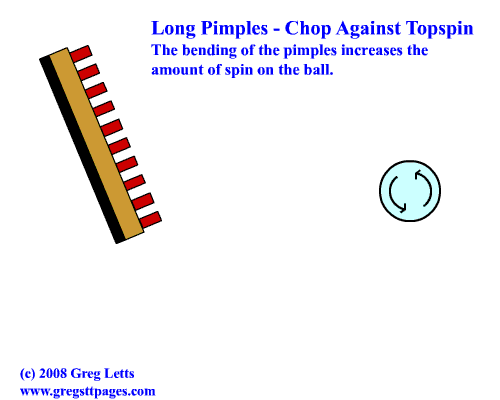
The picture really says it all, but I’ll add a few clarifications.
- As you can see from the animation, you have taken your opponent’s topspin, added to the amount of spin by brushing the ball with your long pips, and then sent the ball back in the other direction, but with the ball spinning faster in the same direction it was originally revolving.
- The amount of spin added by the bending of the pips will depend on your bat speed, bat angle, and how well you brush the ball with the pips. A faster bat, a more open bat angle, and a better brush can really increase the spin on the ball, giving your opponent a really heavy backspin ball to deal with.
- The thickness of your sponge (if any), stiffness of the pips, and amount of grip of the pips will all affect the amount of extra spin you can generate. I’ve found that the amount of sponge isn’t hugely important, but stiffer pips tend to generate less spin, and obviously less grippy pips will increase the spin less.
- Finally, notice that the result of this stroke with long pips is pretty much the same as if you have chopped the ball with a normal inverted rubber – you have increased the amount of spin on the ball, in the same direction as it was originally spinning. You probably haven’t increased it as much as an inverted rubber would, but apart from that it’s pretty much the same.
Long Pimples – Chop vs Backspin
Now let’s look at what happens when you play the same sort of stroke (another chop), but against your opponent’s backspin ball. As you can see from the animation below, the results are very different.
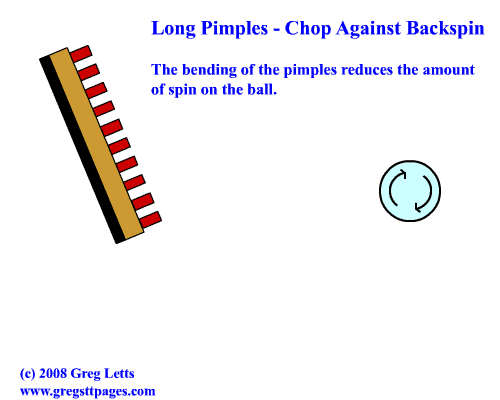
Some points to note:
- Firstly, you have played the exact same shot, but the effect on the ball (and your opponent!) is completely different. In this case you are bending the pips to reduce the amount of spin on the ball, not increase it.
- Also, notice that although you have reduced the amount of spin on the ball, you have not reversed the direction of the spin. So it goes back to your opponent with some topspin on the ball.
- This is completely different to what would have happened if you had played this stroke with a normal inverted rubber, in which case you would have changed the direction of the spin to a counterclockwise direction, which would be backspin to your opponent.
- This is one of the reasons why players who don’t understand long pips complain that they are unpredictable. The result of your long pips stroke is opposite to that of a similar inverted rubber stroke – but it is entirely predictable – it will always work that way.
Long Pimples – ‘Loop’ Against Backspin
OK, now let’s reverse the direction of your own stroke, and see what happens. I’ll start with you playing an upward, loop style stroke against your opponent’s backspin ball. Look below to see what the result is.

Points to note:
- In essence, you are just reversing what happens when you chop against your opponent’s topspin ball. Once again, you are using the bending of your long pips to brush the ball and increase the amount of spin in the original direction, while sending the ball back to your opponent. So his backspin ball comes back to him as a topspin ball, with a little more spin that he originally put on it.
- Again, the end result of this stroke is more or less the same as what your opponent would expect if you had used an inverted rubber – you are increasing the amount of spin on the ball. Maybe not quite as much as an inverted rubber would, but still a similar effect.
Long Pimples – ‘Loop’ Against Topspin
Now let’s see what happens if you play a loop type stroke with your long pips against a topspin ball.
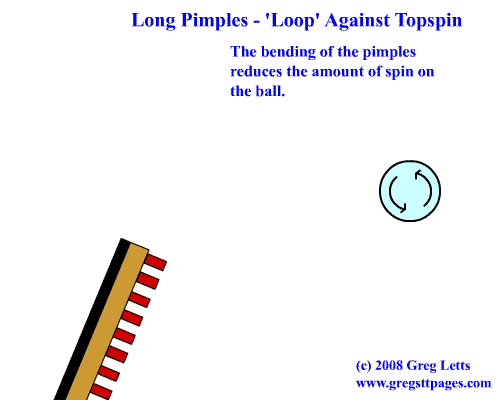
Points to note:
- Even though you have used a topspin style stroke, you have not changed the direction of the spin, you have only reduced the amount of spin a little. It was spinning heavily counterclockwise when it came towards you, and it’s still spinning counterclockwise as it goes away from you, just not as fast. So the ball will return to your opponent as a backspin ball, not a topspin ball.
- The only way you will manage to actually change the direction of the ball’s spin is if your opponent has played a very light topspin, in which case you might be able to change it into a very light topspin ball back. I’m talking very light spin in both cases here.
- Again, this is one of the situations where opponents who don’t understand long pips will tend to get mad. If you had played this stroke with an inverted rubber, you would have changed the direction of the spin from counterclockwise (topspin from your opponent) to clockwise (topspin from you). But instead, the opposite has happened, the ball is still spinning counterclockwise, just a little more slowly. Remember, just because your opponent doesn’t understand what is going on, doesn’t make long pips unpredictable. They will work this way every time – and now hopefully you will be able to predict what will happen!
Long Pimples – Killing Topspin
Finally, let’s take a look at one of the advanced aspects of using long pips – the ability to kill the spin on the ball when your opponent doesn’t expect it, returning a sneaky float ball. Again, I must point out that although the long pips don’t kill the spin the same way as inverted rubber does, they are totally predictable in how they work – you just have to know what is going on.
Take a look at both animations below – the idea is the same for both.
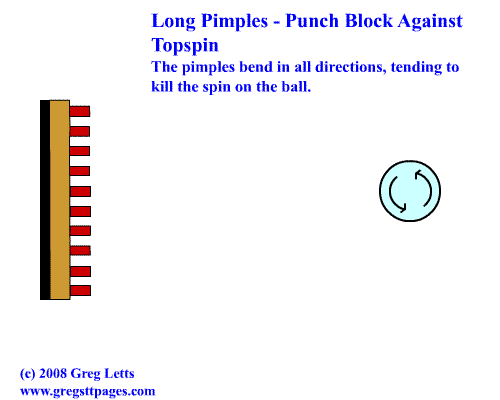
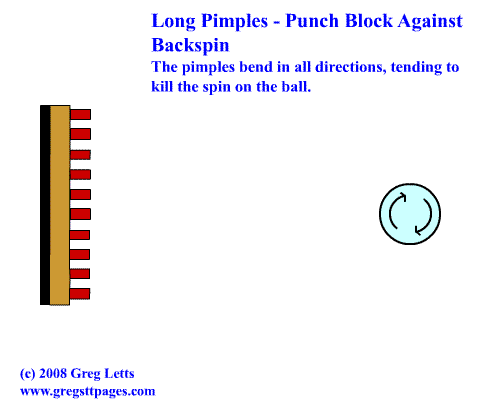
Points to note:
- Firstly, let me just point out that this is not the easiest technique in the world to master. You have to get your bat angle and the direction of your stroke just right, so that your pips bend in all directions, rather than in the same direction. This is not as easy as you might think.
- Secondly, think about the difference between this stroke and how you would kill the spin with a normal rubber. With an inverted rubber, you have to judge the amount of spin the ball has when it reaches you (which is usually much less than your opponent originally put on it due to air resistance), and then put exactly the same amount of spin in the opposite direction to cancel everything out. So you generally end up stroking much more slowly then your opponent, since you are trying to cancel out the smaller amount of spin that is left when it reaches you. This slow stroke usually makes it pretty obvious that you are trying to kill the spin.
- In contrast, with long pips you aren’t trying to reverse your opponent’s spin precisely, you are just trying to grab the ball and stop the spin completely. (It’s like the difference between trying to stop a spinning top by flicking it in the other direction, versus just grabbing the darn thing!). So you don’t have to swing slower, you just have to get the bat angle and direction right. You may not kill the spin totally, but if you do it right you’ll reduce it much more than he thinks! So it’s not easy for your opponent to tell what you are doing – inverted rubber doesn’t work like that.
- Again, this is another example why players who don’t understand long pips get confused – and why you might get confused as well. If you don’t know that long pips can do this – you might accidentally manage to play this type of stroke during a match and leave both you and your opponent scratching your head about what just happened, as the ball takes off in an unexpected direction.
- This is also a great technique to use against opponents who tell you that they have long pips “all figured out”. These type of players usually understand how the bending of the pips can increase or decrease the spin on the ball. Throw this technque at them a few times, and watch them start to scratch their heads and lose their confidence. Lovely stuff!
Conclusion
Obviously, this article isn’t the complete guide to long pips. There’s a lot more to using them successfully then just understanding the basics, but knowing the fundamentals is essential if you are going to be a good long pips player.
An expert long pips player can vary the amount of bending of the pips to increase or decrease the effects, twiddle his bat around to use the other inverted side, or even adjust his swing speed and amount of wrist he uses to completely bamboozle his opponent.


